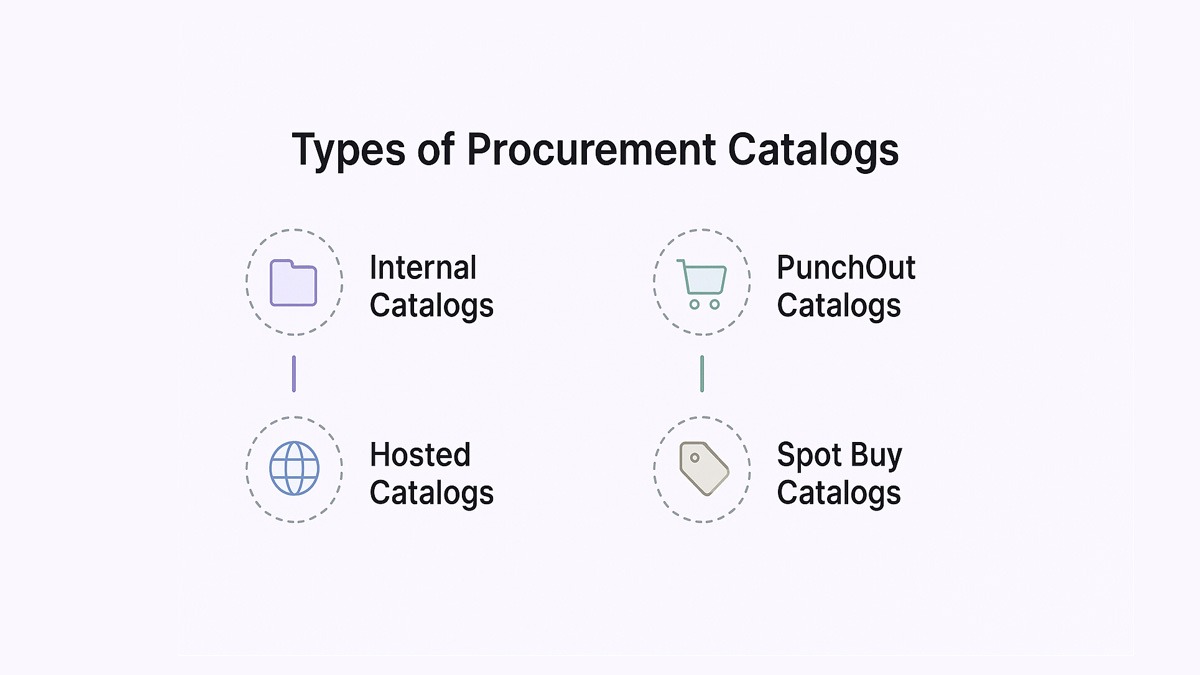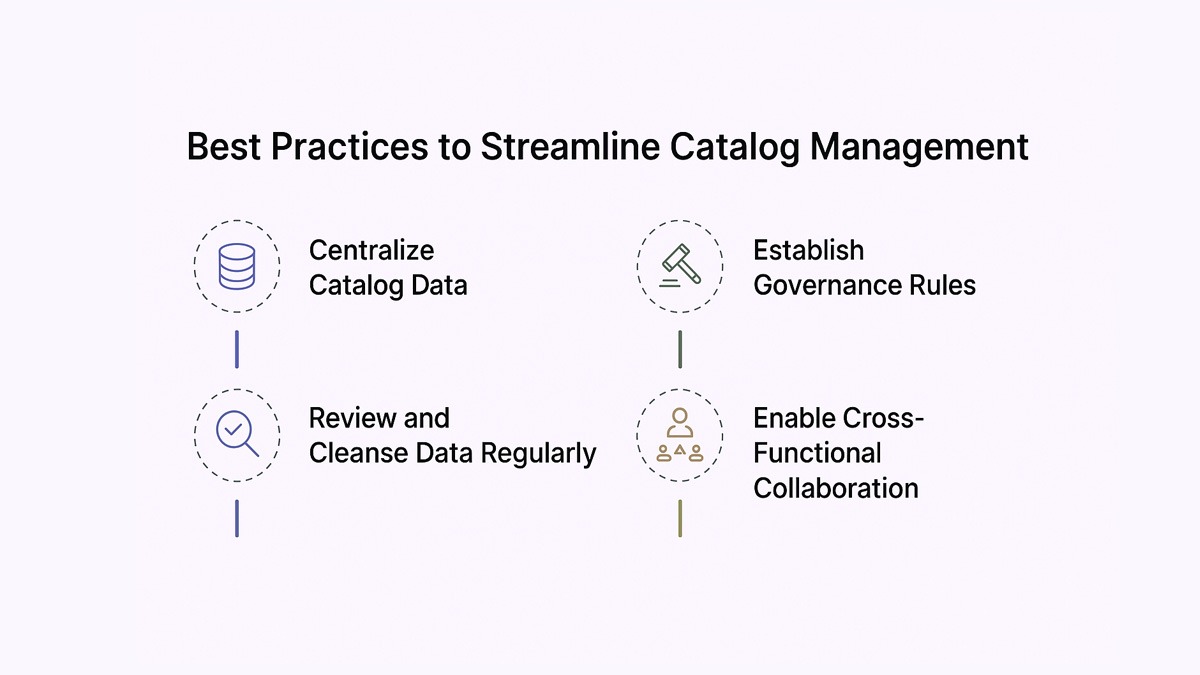

Catalog Management in Procurement: What It Is, Types, Challenges, and Best Practices

Catalog Management in Procurement: What It Is, Types, Challenges, and Best Practices
Learn the types, challenges, and best practices of catalog management in procurement to improve efficiency and supplier collaboration.


A disorganized catalog in procurement is like walking into a supermarket where none of the aisles are labeled. You might eventually find what you need, but not without wasting time, money, and patience. As procurement grows more digital and decentralized, managing catalogs properly has become mission-critical for organizations that want control, speed, and savings baked into their purchasing workflows.
What this blog covers:
- What is catalog management in procurement
- Why catalog management matters for modern procurement
- Types of procurement catalogs you should know
- Key challenges in catalog management
- Best practices to streamline catalog management
- How catalog management improves supplier relationships
- Catalog management and data accuracy: why it’s critical
- Role of technology and PIM systems in catalog management
- Automating catalog updates for efficiency
- How Spendflo helps with catalog management
- Frequently asked questions on catalog management in procurement
What is Catalog Management in Procurement?
Catalog management in procurement is the process of organizing, maintaining, and updating a digital repository of approved goods and services. It ensures buyers have access to accurate, standardized, and real-time product information from trusted suppliers - enabling faster purchasing decisions, streamlined workflows, and better spend control.
Why Catalog Management Matters for Modern Procurement
As businesses scale, procurement complexity multiplies. Catalog management helps simplify this by offering a single source of truth for what employees can buy, from whom, and at what price. It also ensures alignment with established purchasing policies and internal controls. It reduces maverick spend, supports negotiated pricing, and improves operational efficiency. In essence, it ensures every purchase aligns with budget, policy, and supplier agreements - without endless back-and-forth. It’s a foundational element of responsible spend management practices.
Types of Procurement Catalogs You Should Know
Procurement catalogs come in different shapes and formats, each serving unique needs depending on your organization’s size, structure, and procurement maturity. Understanding these types can help you decide which approach - or combination - works best.

Internal Catalogs
These are curated catalogs managed entirely by the procurement or finance team. They contain pre-approved items and negotiated prices from preferred vendors. In decentralized teams, a local catalog may be maintained for region-specific purchases. Internal catalogs are often used for frequently purchased goods, like office supplies or IT peripherals, ensuring compliance and reducing rogue spending.
PunchOut Catalogs
A PunchOut catalog is hosted on the supplier’s website but integrated with your procurement system. It allows users to browse a supplier’s live site, select items, and “punch out” the cart directly into their internal purchasing system. This is great for keeping catalogs up to date without manual effort, but it requires tight integration and supplier collaboration. PunchOut systems are a type of external catalogs maintained by vendors but linked internally.
Hosted Catalogs
In a hosted catalog model, suppliers provide a file or feed (often in formats like CSV or XML) that’s uploaded into your internal procurement platform. This method gives you control over product selection and pricing. These are often referred to as static catalogs because they require manual updates. However, it demands regular updates to avoid outdated pricing or discontinued SKUs.
Spot Buy Catalogs
These are used for one-off or ad hoc purchases that fall outside the typical product catalog. Spot buying offers flexibility when unique, infrequent items are needed. However, overuse can lead to non-compliance and overspending - so it’s best kept to exceptions, not the rule.
Key Challenges in Catalog Management
While catalogs are meant to simplify procurement, they can easily become a source of confusion if not managed well. Let’s unpack some of the major hurdles procurement teams face.
Data Inconsistency
Supplier-provided catalogs often arrive in inconsistent formats. Product names, descriptions, units of measure, or SKUs may vary - even within the same category. Without standardization, it’s nearly impossible to compare vendors or automate the process effectively.
Supplier Onboarding Issues
Bringing new suppliers into your catalog system takes time and coordination. Suppliers may not understand your formatting requirements or may lack the tools to deliver structured data. This delays availability and causes friction in supplier relationships.
Catalog Maintenance at Scale
As the number of suppliers and products grows, maintaining the catalog becomes more time-consuming. Prices change, items get discontinued, and availability fluctuates. Without a dedicated process or automation in place, your catalog can quickly become outdated.
Integration with Procurement Systems
For catalogs to truly drive efficiency, they need to be tightly integrated with eProcurement, ERP, and inventory systems. But many companies still struggle with siloed platforms that don’t “talk” to each other - making it difficult to sync data, approvals, and reporting.
Best Practices to Streamline Catalog Management
Getting catalog management right isn’t just about having a neat product list - it’s about creating a system that scales with your business, stays accurate, and works in harmony with your procurement goals. Here are some proven best practices to help you streamline the process.

Centralize Catalog Data
Avoid the chaos of scattered spreadsheets and disconnected supplier portals. Create a centralized catalog repository where all product and pricing data lives. This helps ensure consistent access across departments and simplifies updates.
Establish Governance Rules
Define who owns catalog management. Whether it’s procurement, IT, or a shared responsibility, everyone should know their role. Set clear rules for how items are added, updated, or removed - and enforce them consistently to maintain data hygiene. This consistency is key to maintaining reliable cost controls across departments.
Review and Cleanse Data Regularly
A “set it and forget it” approach doesn’t work here. Make catalog reviews a recurring event - monthly or quarterly - depending on your purchase volume. Remove outdated items, correct inaccuracies, and update pricing to reflect current supplier contracts.
Enable Cross-Functional Collaboration
Catalogs impact everyone - from finance to operations. Catalog data also plays a critical role in inventory management accuracy. So, bring other departments into the process. Let IT flag non-compliant software purchases. Invite marketing to review creative assets. Catalog usage trends can also provide useful input for demand planning. When multiple teams contribute, the catalog becomes more relevant and complete. A category manager can ensure catalog content aligns with specific sourcing goals.
How Catalog Management Improves Supplier Relationships
A well-managed catalog isn’t just a tool for internal efficiency - it can be a game-changer in how you work with suppliers. Here’s how catalog management strengthens these relationships.
Fewer Disputes, More Trust
When pricing, product specs, and terms are clearly documented and regularly updated, there’s less room for misunderstandings. Fewer disputes over invoices or delivery errors builds trust and reduces back-and-forth with vendors.
Faster Turnaround Times
With products pre-approved and cataloged, orders move faster through your internal system. This efficiency also speeds up accurate purchase order creation. This reduces lead times and helps suppliers plan fulfillment better - creating a smoother supply chain on both sides. A streamlined catalog process directly supports more agile supply chain management.
Opportunities for Strategic Collaboration
Good catalog management gives suppliers data on what’s moving and what’s not. This opens the door to collaborate on bundling, discounts, or optimizing SKUs - making them a strategic partner, not just a transactional vendor.
Better Performance Tracking
Catalog integration makes it easier to track supplier performance by tying orders back to cataloged items. Procurement can use this data to evaluate vendors fairly, reward top performers, or address gaps early. A structured catalog process mirrors the principles of strong content management systems.
Catalog Management and Data Accuracy: Why It’s Critical
Catalog management without clean, accurate data is like running a GPS with outdated maps. You might eventually get there - but expect a lot of detours, missed turns, and wasted time.
Accurate product descriptions, pricing, SKUs, and availability aren’t just “nice to have.” They’re essential for compliance, budgeting, and seamless procurement execution. Incorrect pricing can lead to overpayments. It may also skew cost accounting, leading to budget misalignment. Incomplete specs can result in ordering the wrong items. Inaccurate catalogs can also disrupt asset management tracking downstream. And mismatched SKUs can delay approvals or payments. Data accuracy also fuels better analytics - helping procurement leaders spot trends, control maverick spend, and forecast with confidence. These insights are also critical for effective Supplier Evaluation and contract renewal decisions. Simply put, bad data in catalogs is a hidden cost most companies can’t afford to ignore.
Role of Technology and PIM Systems in Catalog Management
Managing catalogs manually becomes inefficient as supplier numbers and SKUs grow. That’s where technology - especially product information management (PIM) systems - plays a key role.
PIM platforms centralize and standardize product data from multiple suppliers, making it consistent and ready for procurement. They integrate with ERP and sourcing tools, removing the need for manual uploads or duplicate entries. Many PIMs also offer built-in validations, change tracking, and AI-powered features like tagging and auto-suggestions to clean up messy data. For teams handling large catalogs or frequent updates, PIM systems are critical to maintaining accuracy and scaling procurement efficiently.
Automating Catalog Updates for Efficiency
Manual catalog updates can’t keep pace with the speed of modern procurement. Prices shift, products are retired, and terms change often. If your team is still chasing spreadsheets or emails, it’s slowing you down.
Automation fixes this. Most modern procurement software platforms now include catalog automation as a standard feature. With modern tools, catalogs can sync directly with supplier systems or PIM platforms. Any updates - like price changes or discontinued items - are reflected instantly. This avoids errors, stops accidental purchases, and cuts down manual work. It’s a faster, smarter way to keep procurement data fresh and reliable.
How Spendflo Helps with Catalog Management
Spendflo brings structure to catalog management by consolidating product and vendor data into one streamlined platform. Teams get easy access to live, accurate catalogs, with automated approval workflows and real-time updates.
Whether you’re using hosted or PunchOut catalogs, Spendflo ensures consistency, compliance, and alignment with contracts. It also integrates with ERP and P2P tools, so your catalogs stay updated - without extra effort. The result? Less admin, more savings, and smarter decisions.
Frequently Asked Questions on Catalog Management in Procurement
What are the benefits of catalog management in procurement?
Catalog management improves purchase accuracy, reduces maverick spend, speeds up approvals, and ensures buyers use preferred suppliers at negotiated rates. It also boosts visibility and compliance across the procurement process.
How does catalog management impact supplier relationships?
A well-maintained catalog minimizes disputes, enables faster order processing, and provides shared visibility on product details and pricing - strengthening trust and collaboration with suppliers.
Can catalog management be automated effectively?
Yes. Automation tools can sync catalogs directly from suppliers or PIM systems, updating product data, pricing, and availability in real time - eliminating manual errors and delays.
What role do PIM systems play in procurement catalog management?
PIM systems centralize and standardize product data from multiple sources, ensuring clean, consistent information across catalogs. They integrate with procurement tools to keep catalogs accurate and up to date.
What is the difference between a purchase order and a purchase requisition?
A purchase requisition is an internal request to procure goods or services, while a purchase order is the formal document sent to the supplier to fulfill that request. Both are crucial for maintaining procurement control and avoiding unauthorized spending.
How do supplier-managed catalogs help reduce maverick spending?
Supplier-managed catalogs keep product information updated and aligned with negotiated terms, reducing the risk of off-contract purchases. This helps eliminate maverick spending by guiding buyers to approved items within a managed ecosystem.
How does catalog management support a stronger procurement strategy?
Effective catalog management supports a procurement strategy by standardizing purchases, streamlining approvals, and enabling better data analysis across supplier catalogs. It creates consistency and improves strategic sourcing outcomes.










.png)




.png)










.avif)





